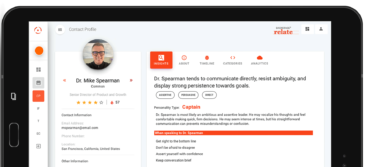Patient engagement for clinical trials has come a long way from the days of using single-tactic campaigns for recruitment. Researchers, more specifically site coordinators, are being heard rather than just escalated. Working through uninterested and unqualified participation leads from traditional media buys is fortunately becoming a thing of the past. The patient voice is also growing in the process today, as pre-study planning and recruitment can be informed by patient behaviors, not just patient health profiles. As a result, before a clinical trial is launched, you can more clearly understand where you will be getting your engaged patients.
The digital transformation affecting industries around the world has changed the clinical trial process as a whole. In recruitment, while the use of digital-based outreach is increasing, the process for implementing it can still be time and resource intensive without an appreciation for the patient experience during the process. No plan for enrollment will work twice as every study has unique requirements and the standard of care has likely evolved since a previous study.
In many cases, major players in the industry are taking smaller steps than others at adopting digital strategies, such as social media, while attempting to follow FDA guidance on including patient advocacy is limited to a handful of opinions from large foundations. While this does attempt to broaden your access to qualified patients, checking the box on those digital tactics alone simply won’t generate much.
Diversifying the Outreach Approach
It is essential to take this process a step further with a diversified outreach approach built around the patient voice. This includes, at a minimum, broadening your network of patient advocacy communities to 30-40 groups, enhancing social media tactics, creating inbound pre-registration websites, and researching naive physician referrals. However, the feedback from these campaigns will generate value only once it’s collected in an actionable method, analyzed for the purpose of understanding what patients are truly communicating, and then learned in a way that adapts the research. Without the openness of an adaptive recruitment approach, most of the important benefits of this feedback are lost.
An example of how a fully diverse and adaptive recruitment works can be seen in a recent moderate-to-severe atopic dermatitis study. Ten advocacy group campaigns were launched along with Facebook Pixel targeting ads. Additionally, using conversion-based Google AdWords instead of cost-per-click AdWords reduced spending by two to three times per participant and improved targeting to spam less people. After the first two to three months analyzing patient and site behavior, it was possible to rank the most effective recruitment strategies to refocus the remaining budget and timeline. This included retargeting a specific type of advocacy group that had a 95% reach rate and 25% enrollment rate.
Certain sites outperformed on referral scheduling rates and others outperformed on referral enrollment rates. Based on acquisition cost and enrollment predictability, ads were developed to target these sites with conversion-optimized AdWords. Any remaining budget was used to broaden reach so that improved strategies would continue to emerge. The result: 42 enrollments at an 8:1 referred to enrolled rate at targeted sites. Adapting the campaign throughout the process resulted in $2.7 million in cost savings. The study met timelines and the median net promoter score from researcher sites was nine out of 10.
Using this adaptive enrollment approach, significant process improvements to recruitment can be made with technology. It has proven to drive 300% improvements in enrollment while using less, but better targeted media. When done right, adaptive patient engagement tactics can cut the industry average from $80,000-$100,000 spent per study participant to under $10,000 averages. With a few of the components discussed below, research can move quickly to adopt ways to improve the patient experience and accelerate patient engagement strategies with confidence.
Study Design Based on Actual Patient Feedback
Optimal patient enrollment almost always requires feasibility assessments for the design of a clinical trial, determining from the outset if the goals are ultimately achievable. Incorporating the patient voice from some of the processes mentioned above is often the most important part of feasibility.
Well-designed trials assess and minimize the study burden on patients; therefore, it’s important that this feasibility data is actually reliable. Advocacy group campaign outreach provides the gold standard insights for knowing if your budgets and timelines reflect the realities for patient participation. Effective recruitment strategies also require a hard look at this data early in the process to determine site selection and final protocol design.
Pharma researchers must determine the availability of a study population and vet many diverse recruitment strategies before committing to a scaled patient recruitment plan. Matching patients based almost entirely on their health profiles may yield a pool of potential participants that initially seems promising, but eventually, will be disappointing because there was little to no consideration of the non-clinical factors that affect participation. These factors may include time and travel commitments or specific study procedures. Identifying these behavioral or environmental factors early can inform the protocol, allowing you to identify the best and most likely prospects based on all factors.
Site Selection Can Be Informed By Feasibility Data
The feasibility data gathered from patients also helps site selection to align it with study design and endpoints when coupled with additional insights on sites you are considering. As with patients, behavioral factors are also important with site selection. It’s not enough to select sites based on survey responses and database sizes. Over-reliance on sites based on forecasts from their database are one of the primary reasons the patient recruitment space has ballooned to an $11 billion market.
Feasibility data gives a geographical lens on which patient communities are underserved and what the total cost of ownership looks like for models that involve travel reimbursement for the most interested patients and sites. If site selection and site expectations are effectively managed to incorporate patient follow up strategies, sponsors can minimize their overdependence on site databases and limit overspending on recruitment.
Expanding Your Options with Broad Advocacy
Access to broad and diverse pools of potential subjects is one of the most important places to begin for successful study enrollment. Beyond this point, it’s important not to lose sight into how patient advocacy groups are the communities most affected by new research outcomes. To ignore them or gloss over them in your research design is to exclude feedback from the most important stakeholders in the process.
Broad patient advocacy refers to the full list of 40 to 200 (based on indication) study-specific communities that care most about research progress. This is not to be mistaken with utilizing just one large indication-specific advocacy organization or foundation. Broad patient advocacy involves a process of continuous relationship building and partnership management for national, regional, indication specific, and general therapeutic area communities. It also includes powerful social media groups and influencers with which patients are heavily engaged on a daily basis.
Patient advocacy groups are vital because they have active community members who are looking for access to new research and an improved standard of care. Whereas researchers might previously have had one or two patient advocacy groups associated with their field of study, we now live in a world where most research projects can call on 50 or more patient advocacy groups globally. Developing these relationships has allowed us to align with 3,500 health organizations and counting, providing an unprecedented level of access to patient networks for Sponsors and CROs.
Your patient engagement campaign can leverage your advocacy group relationships in research planning and execution.
Public Awareness Campaigns During Study Design
When planning recruitment, it is important to assess the acquisition costs and distribution at a much earlier stage than most are doing now. The benchmarks used in recent years are becoming outdated as we learn more about the influence of broad advocacy before the clinical trial begins.
Getting a full picture of which patient populations are out there and feasible for outreach, including cost per channel, is pertinent in this process. It not only allows for comprehensive research participation planning in terms of number of subjects and regions; it helps you get a picture of how you can diversify the demographics of your participants and ultimately, produce more reliable research outcomes.
Engaging with patient advocacy groups through what we call public awareness campaigns before the trial, incorporates the patient voice to develop a more accurate forecast of what it will take to get the trial done on time.
This pre-work can also help you navigate the more risk-averse patient population that might need more time than others to decide about participation. They may be amenable if you engage with them over a longer period of time and establish more trust.
Broad Advocacy During Open Enrollment
An adaptive approach to many of the components leading up to the actual recruitment phase is critical and stays critical throughout enrollment. The pre-awareness campaigns mentioned above set you up to find engaged patients from various communities. Broad advocacy still applies throughout the actual recruitment phase as well, as you want to continue to hone in on what groups and which tactics to reach them are delivering the best patients for the trial. Patient feedback and data will continue to boost campaign strategies until the final patient has been enrolled. This dynamic process ensures campaigns are always operating at peak performance levels or evolve to get them there.
Improving Your Referred to Enrolled Ratio
The understanding of patient journeys, research feedback, participation data, and expectations of the broader patient communities not only informs your strategic plans, but also prevents you from recruitment options that are overly expensive and focused on the wrong patients/stakeholders.
It is now possible to avoid challenging, yet common tactics such as site proliferation, pressuring CRAs to focus on disinterested sites, and an overall unsophisticated patient recruitment marketing.
The results in recent studies prove how patient feedback from partnership with patient advocacy groups is revolutionizing pharma research. This advocacy-based model not only helps reduce referred to enrolled rates down to 10:1 from an industry average of over 50:1, but gives the rightful voice to the communities that are most affected by research to improve and expedite positive outcomes.
Approaching these components of patient enrollment with a deep understanding of the patient voice and how to use the feedback is revolutionizing this key aspect of pharma research. Optimal patient enrollment strategies can reduce enrollment costs 75% to 90%. More importantly, pharma can dramatically improve the efficacy of trials and make life-changing medications available sooner, with more confidence that the needs of the patient community are being served.
Case Study: ALS Clinical Trial Identifies Best Prospects Using Broad Advocacy
The Problem
A mid-sized sponsor addressing ALS, or amyotrophic lateral sclerosis, was embarking on a new Phase III clinical trial and had long been disappointed with the slow pace of research and donors questioned why their funds were not resulting in more clinical advances. One of the biggest impediments was the difficulty in recruiting, enrolling, and sustaining the engagement of patients in clinical studies.
Sponsors typically spend from $40,000 to $98,000 to enroll a single patient with ALS. And even after all the time and expense, enrolled patients sometimes did not follow through with trial participation or proved unsuitable for the research requirements.
The Solution
The Sponsor worked with Leapcure to pursue better results in the timeline, cost of acquisition, and the quality of the trial participants. Leapcure engaged ALS patient communities, reaching out to 157 ALS advocacy groups and formally launching partnerships with 25. With the company’s technology platform allowing it to quickly launch these partnerships and determine members’ interest in clinical trial participation, Leapcure was able to identify the patients who would offer the highest likelihood of success for research coordinators.
Four partner advocacy groups rose to the top as having members particularly interested in trial participation and likely to suit the research requirements, so Leapcure conducted multiple campaigns with those groups. Some patient advocacy groups that yielded a high level of participation probably would not have been contacted without the application of Leapcure’s tech-enabled patient engagement services because they were relatively small and off the beaten path, such as a Swedish ALS patient registry group.
In addition to patient recruitment and facilitating communication between patients and the research coordinator to determine suitability for participation, Leapcure helped shape marketing efforts and patient screening parameters for adaptive recruitment.
Results
Leapcure helped this pharma company enroll 30 patients with ALS at an average cost of $6,567 per patient. The company reached 5,405 patients and referred 518, for a referral-to-enrolled ratio of 17:1. The media cost per ALS patient was $22, with a media cost per enrolled patient of $2,667, and overall the pharma saved more than $1 million by using Leapcure’s approach to patient enrollment.








